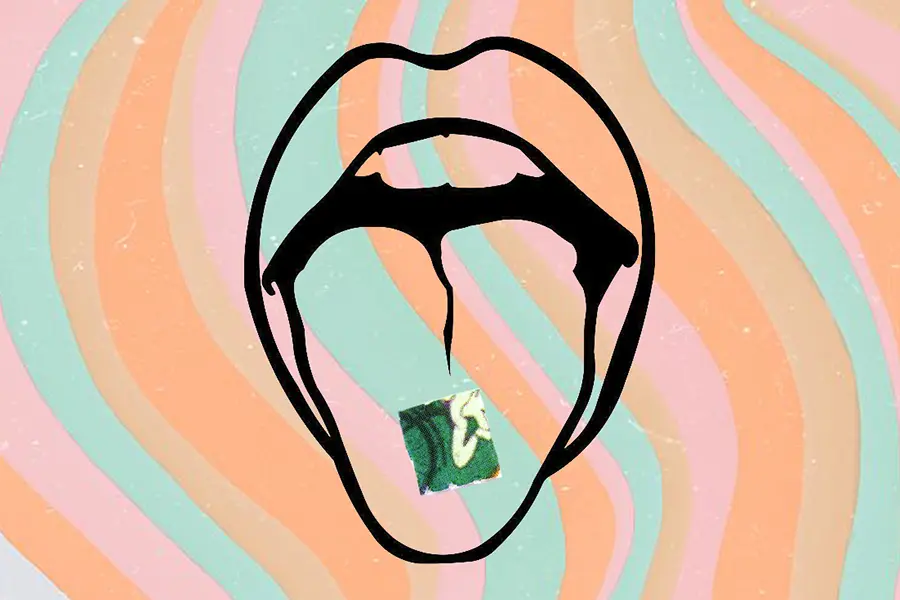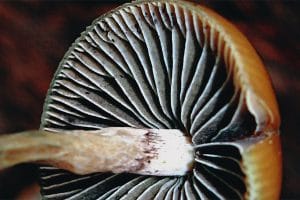I began microdosing in April of 2017 with 15 micrograms of 1P-LSD every three days. 1P, the acid analogue, was legal at the time in Germany, where I had been living and working as an American expatriate. Prior, I tried acid once in college—a case of the giggles-turned-eeriness in Golden Gate Park—but after a microdosing seminar in Berlin, hosted by the German Psychedelic Society, I was convinced that microdosing could mitigate my depression.
A few days following the talk I microdosed for the first time. Months of depression immediately lifted away. It redirected my focus, allowing me to notice things I hadn’t before: the ripples in the Landwehr canal, the steam from my morning bun. I wasn’t high, I didn’t appear to be high, but I felt more comfortable. My mind wasn’t down its usual route: particular fixations and negative ideations. This was different, more light. A way of being I immediately liked.
I began microdosing regularly for the next eight months.
This was the peak of the microdosing trend—it was covered in The New York Times. The Economist. The Washington Post—largely thanks to the momentum around psychedelic research and Ayelet Waldman’s book A Really Good Day: How Microdosing Made a Mega Difference in My Mood, My Marriage, and My Life.
With the buzz, came skepticism. Some psychonauts scoff at the concept of microdosing and are quick to correct others in their use of the term “macrodosing,” with snide comments on Reddit like, “You mean just dosing, right?” Michael Pollan dismissed microdosing when asked about it on his How to Change Your Mind book tour, once telling a crowded auditorium in Santa Rosa, California, that it was “not the way,” but solely a tool for capitalistic advancement.
Sitting in the back of that auditorium, I remember feeling irked by his answer. Negative remarks about microdosing seemed to minimize the progress people were reporting for a variety of conditions like depression, migraine headaches, premenstrual dysphoric disorder (PMDD), and traumatic brain injury. I was one of many who believed microdosing significantly reduced my suffering. Like Waldman, it hampered debilitating mood swings and enabled me to participate in daily life again.
I stopped microdosing in January of 2018 after making (what felt like) progress dealing with my mood disorder. Within weeks, the depression creeped back as if it had never really left. And I’m not the only one who’s experienced this:
How to Grow Shrooms Bundle
Take Both of Our Courses and Save $90!
“As with psychiatric medicines there are going to be side-effects, and in my experience cessation from a dosing regimen can cause problematic side-effects, in my case it was heavy depression and suicide ideation, lasting for about a week after stopping microdosing,” as one Reddit user put it.
“My depression came back, but not at the same intensive suicidal thought force and rate,” said another.
Waldman, on the other hand, says her depression hasn’t come back as severely since she began microdosing, but she wishes she had access to more acid and believes continued use would allow her to feel “more stable, less inclined to depression, and more content.”
Psychedelic research pioneer James Fadiman, a.k.a. “the Father of Microdosing” and creator of the most widely used microdosing protocol—one day on, two days off, for one month—advises that afterwards, people dose as they wish. And that’s where things got tricky for me.
Even if I wasn’t necessarily high on a microdose, it was still an altered state that I began to chase. And efficacy as a mood stabilizer seemed to require continued use. So I kept dosing and dosing throughout 2018 and into 2019, as a spot-treatment for depressive dips, every few weeks.
Microdosing became my band-aid treatment for not only low moods, but also any time I craved a lift. If I felt a little sad, I’d microdose. If I had something to write, I’d microdose. If I was going on a hike, I’d microdose. As soon as my supply was dwindling, I’d get more. Microdosing reaffirmed my all-too-American tendency to dose through or enhance everything; meanwhile, it also kept me complacent prolonging what I really needed to do: address the root causes of my emotional imbalance.
Although I worked up a psychological dependency on microdosing, I was never worried about any negative health repercussions. I trusted what I had heard from others who have been using psychedelics safely throughout long and healthy lives. I trusted Albert Hofmann’s original hunch that small doses could be used “as a euphoriant or antidepressant.” And I trusted the anecdotal reports.
Read: You Can Now Buy a Microdosing Kit Online
Looking back, I still don’t think microdosing continuously was harmful to my health. A recent study published in Psychopharmacology shows that microdosing LSD does not impair cognition, balance, or bodily awareness. If anything, many people—sick or well—could benefit from the heightened awareness, introspection, and creativity that microdosing stimulates.
But what are the long-term effects of microdosing?
I posed this question to Sophia Korb, Fadiman’s research partner, who admitted that nothing can be said about the long-term effects of microdosing at this moment. Korb could confirm that people who microdose report the same benefits as those who macrodose, and over time, tend to need lower doses less often. But the longest microdosing records in their database range from three to five years.
In the summer of 2019, after two years of dosing, my final few microdoses shot me into extreme anxiety and unease. I haven’t microdosed since. It could be that I needed to lower my usual 15 microgram dose, as Korb said many people do over time, but I’m glad I moved on and now have a better understanding of my relationship to microdosing.
For the first time in years, I don’t feel the need to control my moods. I still feel down from time to time, but that’s okay. It comes and goes. However, I don’t think I would have come to this change of perspective this soon without a few substantial doses of ayahuasca and a recent near-death experience (which was arguably psychedelic). What’s more radical now than constantly altering my consciousness is being grateful to be conscious at all. Not spiraling underneath waves, uncertain which way was up, on the verge of sinking— but simply breathing, pulsing, sensing.
Self-described “entheogen enthusiast” Willy Christie believes that “these medicines are to facilitate a deep healing experience, not a small siddhi to amplify a certain (usually corporate) lifestyle.” That’s not to say that people shouldn’t do it, he clarifies. “I just think it’s almost a perversion of one of the last few sacraments we have.” Some might argue that microdosing helps them integrate those larger doses, like a supplement.
Maybe Pollan’s overarching message of quality over quantity has been right all along. To each their own, but for me, periodically tripping on large doses of LSD, San Pedro, ayahuasca, or shrooms—with long intervals in between to notice and practice behavioral shifts, ideally with external support—seems to be the most sustainable solution for my continued psychedelic use. And while there will undoubtedly be a variety of psychedelic uses for different people, I hope advocates working to end prohibition also seek to understand why people—especially Americans—feel the need to dose more than ever before.

DoubleBlind is a trusted resource for news, evidence-based education, and reporting on psychedelics. We work with leading medical professionals, scientific researchers, journalists, mycologists, indigenous stewards, and cultural pioneers. Read about our editorial policy and fact-checking process here.

DoubleBlind Magazine does not encourage or condone any illegal activities, including but not limited to the use of illegal substances. We do not provide mental health, clinical, or medical services. We are not a substitute for medical, psychological, or psychiatric diagnosis, treatment, or advice. If you are in a crisis or if you or any other person may be in danger or experiencing a mental health emergency, immediately call 911 or your local emergency resources. If you are considering suicide, please call 988 to connect with the National Suicide Prevention Lifeline.



